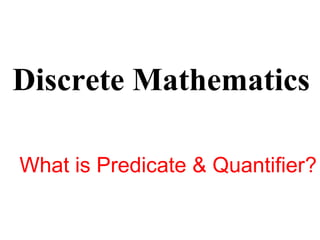
Predicate & quantifier
- 1. Discrete Mathematics What is Predicate & Quantifier?
- 2. Predicate • “x > 3,” “x = y + 3,” “x + y = z,” • “computer x is under attack by an intruder,” • These statements are neither true nor false. • How propositions can be produced from such statements? • “x is greater than 3” has two parts. The first part, the variable x, is the subject of the statement. The second part—the predicate, “is greater than 3” • Let P(x) denote the statement “x > 3.” What are the truth values of P(4) and P(2)? • Solution: We obtain the statement P(4) by setting x = 4 in the statement “x > 3.” Hence, • P(4), which is the statement “4 > 3,” is true. However, P(2), which is the statement “2 > 3,”is false.
- 3. Some example • Let Q(x, y) denote the statement “x = y + 3.” What are the truth values of the propositions Q(1, 2) and Q(3, 0)? • Solution: To obtain Q(1, 2), set x = 1 and y = 2 in the statement Q(x, y). Hence, Q(1, 2) is the statement “1 = 2 + 3,” which is false. • The statement Q(3, 0) is the proposition “3 = 0 + 3,” which is true.
- 4. Quantifier • Quantification expresses the extent to which a predicate is true over a range of elements. In English, the words all, some, many, none, and few are used in quantifications.
- 5. Universal & Existential quantifier • The notation ∀xP(x) denotes the universal quantification of P(x). Here is∀ called the universal quantifier. We read ∀xP(x) as “for all xP(x)” or “for every xP(x).” P(x) is true for all values of x in this domain. • We use the notation ∃xP(x) for the existential quantification of P(x). Here is called existential quantifier.the P(x) is true for∃ at least one value of x in the domain.
- 6. Example of universal quantifier • Let P(x) be the statement “x + 1 > x.” What is the truth value of the quantification xP(x),∀ where the domain consists of all real numbers? • Solution: Because P(x) is true for all real numbers x, the quantification ∀xP(x) is true. • Let Q(x) be the statement “x < 2.” What is the truth value of the quantification xQ(x), where∀ the domain consists of all real numbers? • Solution: Q(x) is not true for every real number x, because, for instance, Q(3) is false. That is,x = 3 is a counterexample for the statement xQ(x).∀ Thus ∀xQ(x) is false.
- 7. Example of existential quantifier • Let P(x) denote the statement “x > 3.” What is the truth value of the quantification xP(x),∃ where the domain consists of all real numbers? • Solution: Because “x > 3” is sometimes true for instance, when x = 4 the existential quantification of P(x), which is xP(x), is true.∃ • Let Q(x) denote the statement “x = x + 1.”What is the truth value of the quantification xQ(x),∃ where the domain consists of all real numbers? • Solution: Because Q(x) is false for every real number x, the existential quantification of Q(x),which is ∃xQ(x), is false.
- 8. Some examples “All lions are fierce.” “Some lions do not drink coffee.” “Some fierce creatures do not drink coffee.” • Let P(x), Q(x), and R(x) be the statements “x is a lion,” “x is fierce,” and “x drinks coffee,” respectively. Assuming that the domain consists of all creatures, express the statements in the argument using quantifiers and P(x), Q(x), and R(x). • ∀x(P(x) → Q(x)). • ∃x(P(x) ∧ ¬ R(x)). • ∃x(Q(x) ∧ ¬ R(x)). • Notice that the second statement cannot be written as ∃x(P(x)→ ¬ R(x)). The reason is that P(x)→ ¬ R(x) is true whenever x is not a lion, so that x(P(x)→∃ ¬ R(x)) is true as long as there is at least one creature that is not a lion, even if every lion drinks coffee. Similarly, the third statement cannot be written as ∃x(Q(x)→ ¬ R(x)).
- 9. Some examples • “All hummingbirds are richly colored.” • “No large birds live on honey.” • “Birds that do not live on honey are dull in color.” • “Hummingbirds are small.” • Let P(x), Q(x), R(x), and S(x) be the statements “x is a hummingbird,” “x is large,” “x lives on honey,” and “x is richly colored,” respectively. Assuming that the domain consists of all birds,express the statements in the argument using quantifiers and P(x), Q(x), R(x), and S(x). • Solution:We can express the statements in the argument as • ∀x(P(x) → S(x)). • ¬∃ x(Q(x) R(x)).∧ • ∀x( ¬ R(x)→ ¬ S(x)). • ∀x(P(x)→ ¬ Q(x)).
- 10. Try yourself • Let P(x) be the statement “x can speak Russian” and let Q(x) be the statement “x knows the computer language C”. Express each of these sentences in terms of P(x), Q(x), quantifiers, and logical connectives. The universe of discourse for quantifiers consists of all students at your school. • • (i) There is a student at your school who can speak Russian and who knows C. • • (ii) Every student at your school either can speak Russian or knows C. •
